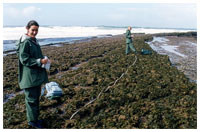home > research > evolution of reproductive strategies in fucoid algae: phylogeny, population genetic structure, and sexual phenotypes of dioecious versus hermaphrodite Fucus species.
Evolution of reproductive strategies in fucoid algae: phylogeny, population genetic structure, and sexual phenotypes of dioecious versus hermaphrodite Fucus species
 Hybridization between these two species has been suggested by reports of individuals with intermediate morphologies. Another goal was thus to use microsatellite data to gain accurate estimates of hybridisation frequency. Hybrid zones are excellent models for the study of evolution and maintenance of contrasting reproductive systems, as they are stabilized by the balance between introgressive gene flow and selection against hybrids contributing to maintenance of parental species integrity.
Since the cosexual/unisexual reproductive character has changed several times during the evolutionary history of the Fucaceae, the change from one reproductive system to the other may be relatively simple.
Hybridization between these two species has been suggested by reports of individuals with intermediate morphologies. Another goal was thus to use microsatellite data to gain accurate estimates of hybridisation frequency. Hybrid zones are excellent models for the study of evolution and maintenance of contrasting reproductive systems, as they are stabilized by the balance between introgressive gene flow and selection against hybrids contributing to maintenance of parental species integrity.
Since the cosexual/unisexual reproductive character has changed several times during the evolutionary history of the Fucaceae, the change from one reproductive system to the other may be relatively simple.  We are continuing to investigate the reproductive system evolutionary steps along the evolutionary history of fucoid algae by means of mapping these onto molecular phylogenies.
In the evolution from one reproductive strategy to another, while sexual differentiation is still incomplete one may expect to find populations of mixed sexual phenotypes, e.g. female or male and hermaphroditic morphs are observed. To understand the evolutionary mechanisms underlying the transition from one reproductive strategy to another, we are studying the sexual phenotypes of individuals in populations, and assessing the investment into male and female function of each sexual phenotype.
We are continuing to investigate the reproductive system evolutionary steps along the evolutionary history of fucoid algae by means of mapping these onto molecular phylogenies.
In the evolution from one reproductive strategy to another, while sexual differentiation is still incomplete one may expect to find populations of mixed sexual phenotypes, e.g. female or male and hermaphroditic morphs are observed. To understand the evolutionary mechanisms underlying the transition from one reproductive strategy to another, we are studying the sexual phenotypes of individuals in populations, and assessing the investment into male and female function of each sexual phenotype.On top, fucoid beds at Viana (photo by Soraia Santos); above Marta Valente and Carolyn Engel sampling Fucus spiralis, Ericeira (photo by Claire Daguin)
more photos


